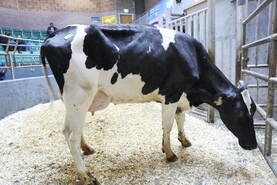While a good water system is vital for every enterprise, due to the nature of dairy farming, there is higher demand at certain times of the day.
A cow will typically drink at a rate of 14l/minute and this should be factored in when deciding on what size trough to install. Dairy cows will generally consume 30-50% of their water intake within three hours of milking, or a total of over 70l/day.
The water infrastructure that worked when you had 100 cows might not be sufficient for your 200-cow herd
This means that on average, each cow drinks approximately 4.5l/hour for the three hours after milking. For a 150-cow herd, this would put demand of 675 litres for each hour.
For many farms that have expanded over the past few years, water systems may be coming under pressure. The water infrastructure that worked when you had 100 cows might not be sufficient for your 200-cow herd.
It is recommended that the internal diameter of the pipe should be 25mm for up to 150 cows, 32mm for 150-300 cows and 40mm for more than 300 cows, according to Teagasc. Connections from the main line to the water trough should not be more than 50m and the connecting pipes can be 25mm.
We saw last summer during the drought the importance of having a sufficient water system for cows
While a larger trough may be a short-term solution to a water issue in paddocks, as it will provide more drinking space for cattle, ultimately when there is a poor flow rate it will leave the herd under pressure for water, particularly at peak times. We saw last summer during the drought the importance of having a sufficient water system for cows.
The guideline figure is to allow 9l of water reserve per cow in each paddock – this is the equivalent of two gallons.
Loop system
The Salesian Agricultural College recently upgraded its water system on the farm by installing a loop system. Creating a loop means that water is approaching troughs from both sides, which leads to increased pressure. This is especially useful for the furthest-away troughs, where water pressure might be poor.
Farmers in derogation must be aware that they have to keep drinking points at least 20m away from a watercourse
Troughs do not have to all be located directly off this main loop and can be joined by a connecting pipe while still benefiting from the extra pressure of the loop system.
More and more dairy farmers are positioning water troughs in the centre of fields, which provides increased flexibility for grazing and it is something that drystock farmers should really consider doing if upgrading their system.
Farmers in derogation must be aware that they have to keep drinking points at least 20m away from a watercourse.
This is to prevent ground becoming poached and the leaching of nutrients to a nearby watercourse.






 This is a subscriber-only article
This is a subscriber-only article










SHARING OPTIONS: